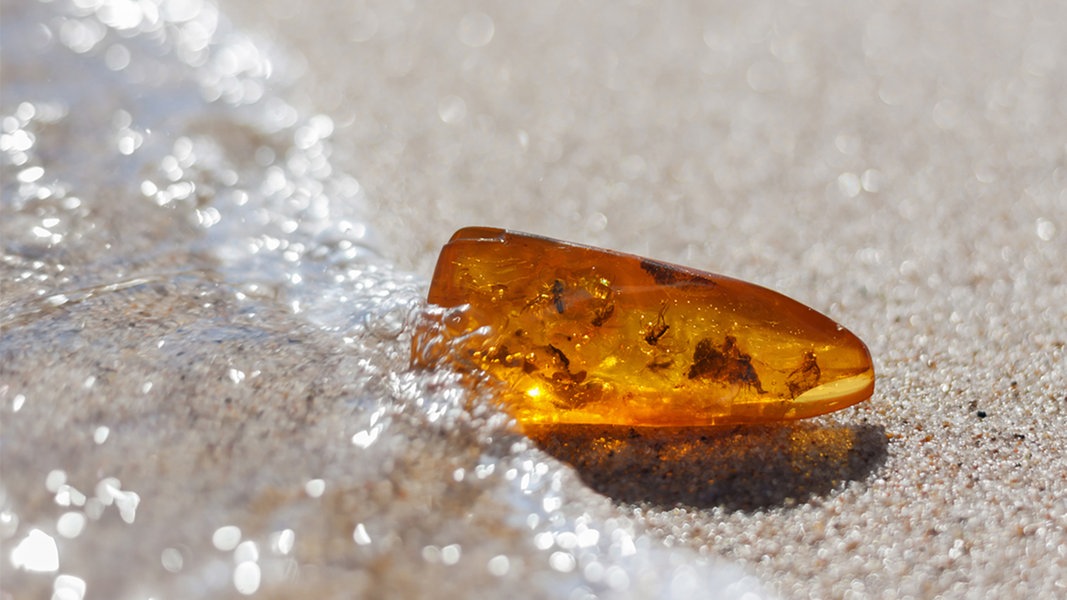As of: February 8, 2024 4:10 p.m
Amber is a fossil resin and has fascinated people for a long time. The light brown chunks wash up on the coast, especially after cold, stormy nights. Tips for collectors.
Especially in autumn and winter, after stormy nights with onshore winds, attentive beach visitors, with a bit of luck, come across the gold of the sea: amber. The sought-after fossil resin only floats up when the salty seawater is cold and therefore very dense. However, if the water is warm in the summer months, the chances of finding amber are poor.
Search for amber in autumn and winter with a UV flashlight
Amber is sometimes hidden between sand and shells. If you want to find them, you have to look closely.
It is therefore best for collectors to go out after autumn and winter storms. However, as soon as there is a strong wind, there are usually other amber hunters on the beaches, so it is advisable to get up early. A special UV flashlight with protective glasses can be very useful: When amber is exposed to UV light, it begins to glow in the dark. Amber is usually hidden between seaweed, wood, small stones and mussel shells in the so-called flushing seam on the beach.
Recognize amber: test with salt water and wool cloth
Compared to real stones, amber is very light and shines in the sun. Raw amber often looks brownish to honey-yellow, sometimes it also has a whitish, light yellow or reddish shimmer. If you are not sure whether something you find is amber, you can easily tap it against a tooth. A soft tone indicates amber – the similar-looking yellow flints sound much harder. Authenticity can also be tested with very salty water: amber floats on top. A wool cloth is also suitable for a test: dry amber becomes electrostatically charged when rubbed and attracts scraps of paper and the like.
Severe burns if mistaken for phosphorus
However, it can be dangerous if collectors confuse phosphorus with amber: phosphorus can ignite at temperatures above 20 degrees and cause serious burns. Caution is particularly advised on the Baltic Sea beaches around Rügen and Usedom – but fortunately the finds are still very rare. Since phosphorus and amber are initially difficult to distinguish from one another, it is advisable to first collect the supposed amber in a tin can or a preserving jar and not to put it in your trouser or jacket pocket.
North and Baltic Seas: Which beaches are worth looking for?
The chances of finding the fossil resin are particularly good after winter storms.
Collectors have a good chance of finding amber on the beaches of Mecklenburg-Western Pomerania, especially on Fischland-Darß-Zingst, Hiddensee, Rügen and Usedom. On the Schleswig-Holstein Baltic Sea coast, however, there is hardly any amber. It’s more worthwhile to search on the North Sea coast: on the dune of Heligoland, in the mudflats off St. Peter-Ording and off Büsum, as well as on the beaches of the East and North Frisian Islands.
In some places, those interested can take part in guided tours and look for amber under expert guidance. Particularly in the winter months, some seaside resorts also offer events where holidaymakers can hunt for amber and then process the finds into individual pieces of jewelry.
Amber: Magical and healing powers?
Amber has fascinated people at all times. As early as 10,000 years ago, our ancestors made jewelry from the fossil resin; priests burned it like incense because of its aromatic scent. In ancient times, amber was a sought-after trade good and in the Middle Ages people attributed magical effects to amber: it was considered a protector against witches and demons. Even today, many people believe that it has a healing effect on skin diseases and toothaches. An amber necklace is supposed to help small children when they are teething.
Fossil resin up to 400 million years old
The oldest amber in the world is 400 million years old. Baltic amber, which washes up on Baltic and North Sea beaches, was formed about 40 to 50 million years ago from the resin of subtropical coniferous forests.
Further information
The find is a small sensation, especially for the western Baltic Sea. How much the stone is worth is still unclear. more
Visitors can get to know the city in Western Pomerania, which is known for its amber processing, on two tours. more
This topic in the program:
Northern Tour: Experience the North | 02/25/2023 | 6:00 p.m
